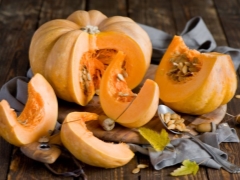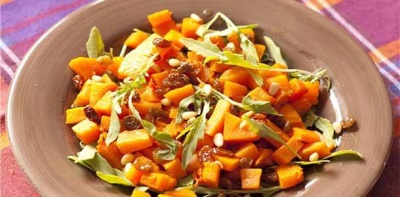Is it possible to eat raw pumpkin for children and at what age to give it?
Pumpkin belongs to the useful products, so it is introduced into the diet of children in the first year of life. However, at the age of 6-7 months we are talking about a heat-treated product - prepared in the form of a puree. A little later, children are offered pumpkin soup and pancakes, porridge with pumpkin slices. But is it possible to give a child such a raw vegetable?
Benefit
The attitude to the pumpkin without heat treatment is different. Someone doubts its usefulness, and someone, on the contrary, is sure that boiling and roasting leads to the destruction of all valuable minerals and vitamins in its composition.
Here is what is known about the raw pumpkin and its use:
- This vegetable is a source of beta-carotene, thiamine, ascorbic acid, vitamin E, niacin, potassium, magnesium, riboflavin, cobalt, iron and many other substances. They are absorbed quite well, helping the body to get what is missing.
- There are many fiber, which makes it useful for the work of the digestive tract, helping to prevent constipation. This is one of the main reasons why they like raw vegetables.
- Due to its high content carotene It has a beneficial effect on vision.
- Calorie is very low therefore, heat-treated pumpkin is often included in the diet and is recommended for overweight.
- Eating helps to strengthen blood vessels, eliminate toxins and cholesterol.
- She noted properties Strengthen defenses, improve sleep, strengthen bones, and stimulate tissue regeneration. In addition, it has an anti-inflammatory effect.
- Since she rich in water and potassium saltsI, dishes with such a vegetable have a diuretic effect and prevent the formation of stones in the organs of the excretory system.
- Unlike boiled or baked pumpkin, contraindicated in diabetes, a raw vegetable does not have a high glycemic index, and able to normalize insulin production in the body. This allows you to include it in the diet of children with diabetes.
You can also learn about the benefits of pumpkin from this informative video:
Harm
- Because of the bright color, she refers to allergenic vegetablestherefore, its use can cause skin rashes and other allergy symptoms.
- In some children, raw pumpkin in the diet can cause digestive disorders.
- Vegetables may contain hazardous substances, such as excess pesticides, which is especially dangerous when consumed raw.
From what age can I give?
A thermally unprocessed pumpkin, like other raw vegetables, can begin to be given to a child at the age of 1-2 years, focusing on the health of the crumbs, as well as the reaction of the digestive tract.
After giving the child a product in a small amount, watch the baby. If no negative symptoms appear, you can continue to give raw pumpkin, increasing its volume.
When can not give?
Although raw pumpkin is rich in vitamins and other valuable substances, it should not be given to children with:
- Individual intolerance.
- Gastroduodenitis.
- Peptic ulcer.
- Gastritis with reduced acidity.
- Hepatitis.
What to cook?
Raw pumpkin is most often one of the ingredients of salads. For example, finely grated vegetable can be mixed with the same amount of grated carrots and green apple, then season with olive oil and honey.Additionally, steamed raisins or chopped walnuts can be added to such a salad.
Unsweetened version of pumpkin-carrot salad can be supplemented with pumpkin seeds, dried in the oven.
Read more about cooking options for the child in the article about pumpkin soup and mashed potatoes.
Watch the program "Live Healthy", where both useful and harmful properties are considered.





























































